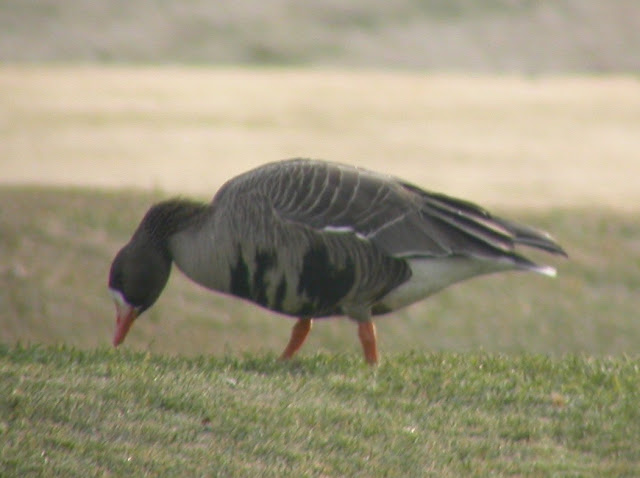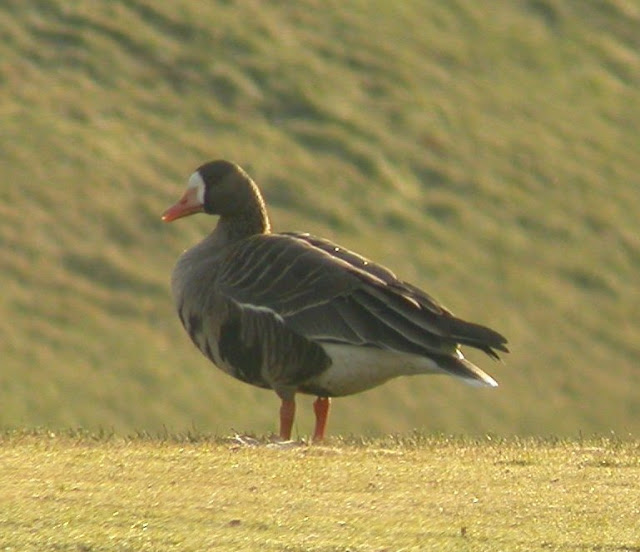Greater White-fronted Geese in the Mid-Atlantic - Part 1
Identifying GWFG to ssp in the mid-Atlantic of the US, given the occurrence of both Greenland (flavirostris) and "Western" (gambelli) has suffered from an over-reliance on perceived bill color to identify birds which can lead to errors given the variability in bill color of gambelli (and flavirostris!), and the challenges of correctly assessing bill. In this blog I look at some Greater White-fronted Geese (GWFG) I've personally seen and photographed in MD, VA and DE and try to assign them to subspecies (following Banks, 2011 Taxonomy of Greater White-fronted Geese, Proceedings of the Biological Society of Washington which assigns all GWFG in arctic Alaska/Canada and the interior of these areas (and therefore the Central Flyway) to gambelli).
I've had the chance to visit Wexford, Ireland, to study flavirostris on their wintering grounds, and also to visit skins collections in the UK and the US. This blog contains some of the criteria I've used in assigning these birds to ssp based upon this:
http://gwfgmdde.blogspot.com/2017/10/greater-white-fronted-geese.html
Assigning a bird to sub-species in the mid-Atlantic needs to take account of a range of additional factors assessed together including overall color, appearance of upperparts fringing and the white flank stripe, extent of white on the tail, bill shape, and the extent of black on the underparts. Size might be helpful, to the extent that very small birds are not likely to be flavirostris but the largest Central Flyway birds are bigger than flavirostris. Many birds might best be left unassigned. My impression from studying skins and birds in the field is that flavirostris is not very variable, but that gambelli is, probably reflecting the greater range and much larger population of gambelli, and that it includes both tundra- and taiga-breeding birds.
This blog has benefitted from comments from Sebastien Reeber and from discussions in the field in Wexford, Ireland, with Killian Mullarney. All errors are my responsibility.
(Unless otherwise stated all photos are © Clive Harris. )
I've had the chance to visit Wexford, Ireland, to study flavirostris on their wintering grounds, and also to visit skins collections in the UK and the US. This blog contains some of the criteria I've used in assigning these birds to ssp based upon this:
http://gwfgmdde.blogspot.com/2017/10/greater-white-fronted-geese.html
Assigning a bird to sub-species in the mid-Atlantic needs to take account of a range of additional factors assessed together including overall color, appearance of upperparts fringing and the white flank stripe, extent of white on the tail, bill shape, and the extent of black on the underparts. Size might be helpful, to the extent that very small birds are not likely to be flavirostris but the largest Central Flyway birds are bigger than flavirostris. Many birds might best be left unassigned. My impression from studying skins and birds in the field is that flavirostris is not very variable, but that gambelli is, probably reflecting the greater range and much larger population of gambelli, and that it includes both tundra- and taiga-breeding birds.
This blog has benefitted from comments from Sebastien Reeber and from discussions in the field in Wexford, Ireland, with Killian Mullarney. All errors are my responsibility.
(Unless otherwise stated all photos are © Clive Harris. )
Bird 1 - Bethesda, MD - December 2008
This bird spent several days in North Bethesda including at Georgetown Prep. Based on bill shape and color this seems to be a gambelli. The bill color is strongly pink compared to the very orange feet in photos taken in shade. In addition the bird consistently showed a concave bill with a "teat" at the end, which is not a shape found in flavirostris. In the photo below, the pink bill and the concave "teat" shape can be seen very well. The photo also shows the strong contrast between the bill color and the legs. In the photo below the white flank stripe is narrow and broken but this is probably because of the position of the wing since other photos show a broader white flank stripe. The photos were digiscoped and are not of the best quality.
This bird spent several days in North Bethesda including at Georgetown Prep. Based on bill shape and color this seems to be a gambelli. The bill color is strongly pink compared to the very orange feet in photos taken in shade. In addition the bird consistently showed a concave bill with a "teat" at the end, which is not a shape found in flavirostris. In the photo below, the pink bill and the concave "teat" shape can be seen very well. The photo also shows the strong contrast between the bill color and the legs. In the photo below the white flank stripe is narrow and broken but this is probably because of the position of the wing since other photos show a broader white flank stripe. The photos were digiscoped and are not of the best quality.
Here are some photos that show the concave shape of the bill with the extended "teat". This is a bill shape shown in gambelli but not flavirostris.
|
|
 |
| Clive Harris © Smithsonian Institution. (USNMNH # 367938) |
Bird 2 - Solomons, MD, January 2017
This bird has been returning to winter in the same area for a number of years. This was the first year I got a chance to see it. This is a more difficult bird as the bill color - pinkish-orange - can be found in both forms. Based on the shape of the bird's bill plus supporting characteristics in plumage, I believe this bird also to be a gambelli. In the close-ups below, the bird clearly has a very extended "teat" shape to the outer third of the bill, which is a shape often found in gambelli. Flavirostris usually has quite a different a bill shape and its very hard to find photos or skins of this ssp that match the bill shape of this bird.
The photos immediately below are 3 flavirostris specimens with some of the longest looking bills. Below are three gambelli specimens. The Solomons bird has a bill matching the gambelli, with a longer/thinner shape and a very extended parallel-sided "teat" which is more than a third of the bill length.
|
|
The second photo below is of 3 flavirostris taken on the wintering ground at Wexford in January 2017. Compared to the Solomons bird note the darker faces on these birds, the more wedge-shaped bill, narrow and broken white flank stripes, dark blotching extending well into the white ventral area, and the duller and narrower upperpart fringes. It is worth noting that the left hand bird of the three was one of the best marked, in terms of upperparts, of around 1000 flavirostris I saw on that visit. The right hand two birds are far more typical and many are less well marked than these. More generally I cannot find a flavirostris from my photos from Wexford that show the full range of characters of the Solomons bird.
 |
| Greenland WFG, Wexford, Ireland, Jan 2017 |
Bird 3 - Washington DC, January 2017
This was a relatively petite bird with a small triangular pinkish-orange bill. The shape of the bill fits either flavirostris or gambelli (which seems to have a wide variety of bill shapes). The very broad white flank stripe and broad white tail band and broad white fringing on the outer edges of the tail feathers (particularly the outermost visible) seem to be at or outside the far end of the range for flavirostris. This bird also had a very pale almost whitish belly and well-defined upperparts fringing. As well as the pale belly, the breast of this bird was pale and contrasted well with the darker head and neck. Structurally the bird did not have the blocky-headed look of many flavirostris. The lack of dark belly markings perhaps suggests it is a second winter bird.
This is not a flavirostris. I am not sure how one would rule out albifrons, although that form would have a pinker bill and seems an unlikely form to reach this area. It is presumably a gambelli.
By way of comparison the left hand is a close up of the tail of this bird, compared to 3 typical tail patterns of flavirostris, taken in Wexford Jan 2017 which are in the center and right hand panels.
Bird 4 - Reston, VA, February 2017
The photos below were taken near dusk so the overall color of the bird appears relatively dark. However the very bold, whitish and well-contrasting upperparts markings, the broad white tail band with extensive white fringes on the outer edges of the tail feathers, and the broad white flank stripe indicate this is a gambelli.
By way of contrast, here are some flavirostris showing the narrow/wavy/broken flank stripe typical of that species as well as the poorly marked upperparts.
Finally, in flight the bird showed relatively limited dark markings on the underparts, a broad white-tail band and pale underparts contrasting well with the dark head and neck.
Bird 5 - Frederick, MD, November 2014
This bird, as with Birds # 1 and 2, has been accepted as flavirostris in eBird. Overall this was a fairly pale, greyish brown bird with a strongly contrasting narrow black base to the white frontal patch. The bird appeared relatively small and thin-necked, and had limited black markings underneath, the black not being obviously present in the white ventral area. The flank stripe is fairly solid and continuous and the fringing on the tertials is well-defined, and certainly broader than average flavirostris on the upperparts. The bill color is a bit ambiguous with some orange at the base, and a dull fleshy pink overall. The tail pattern is within range, but at the well-marked end of the range, for flavirostris. The bird was very small (see e.g. size next to Mallard).
This blog is continued here:
http://gwfgmdde.blogspot.com/2017/10/greater-white-fronted-geese-in-mid_1.html




































Comments
Post a Comment